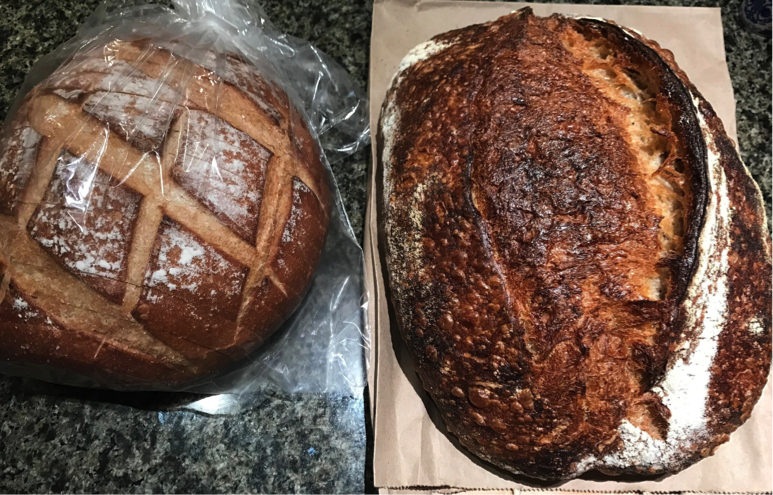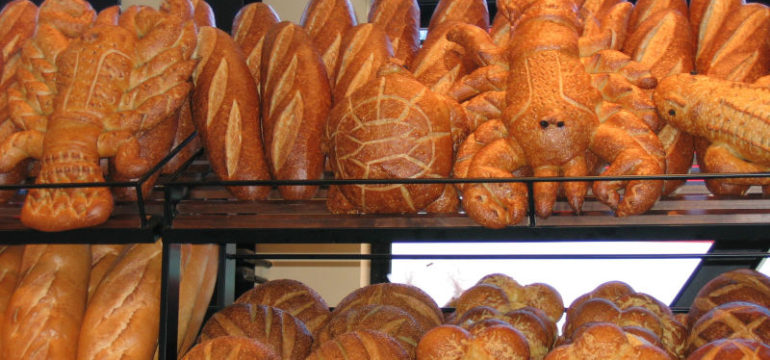BY: AMELIA CHEN
I say New York – you’ll probably say pizza. I say Texas – you’re probably thinking brisket. Some places are just naturally associated with a food. Boston has clam chowder, Seattle has coffee, and San Francisco? We have sourdough. And it’s kind of trending (6).
I’m willing to bet that most have heard of sourdough – it’s always one of the toast options at diners. And the name kind of speaks for itself – it’s bread that has a mildly sour taste. Sourdough is the original and oldest leavened bread, dating back to Ancient Egyptian times. The story goes that some baker forgot about that flour and water he had mixed and left lying out, and when he noticed it later, it was bubbling, growing, and giving off a strange odor (1). We now know this change is due to fermentation by the wild yeasts and bacteria in the air, on the flour, or crawling all over your mixing hand. Candida milleri and Lactobacillus sanfranciscensis are the headliners of this symbiotic culture. While not dependent upon each other, yeast and bacteria make the environment more suitable for each other. They do not compete for the same sugars for food, and when the yeast die, lactobacilli can use the broken down proteins. The sour taste of sourdough is due to the lactic acid produced by lactobacilli and, in addition to imparting the characteristic flavor, the acidic environment prevents other yeasts and bacteria from outgrowing C. milleri which is acid-tolerant (5).
Commercial baker’s yeast was introduced in the nineteenth century and, with Saccharomyces cerevisiae on the scene, bread production became reliable and controllable. Flour, water, and leavening could be transformed into bread in three and a half hours. Additives and processing aids – such as extra yeast, enzymes, emulsifiers, and extra gluten – were used to further improve bread quality, size, texture, and shelf life. However, artisan bakers are proving (I mean, proofing. No? Okay, anyways…) that sometimes the best method is to take it slow.

Left: Sourdough loaf from Boudin Bakery, Right: Country loaf from Tartine Bakery & Cafe
I spent a Sunday morning gathering a couple of San Francisco’s sourdough samples. By the way, I later learned were on opposite sides of the spectrum according to Serious Eats (3). Boudin Bakery, which was started by French baker Isidore Boudin in 1849, makes a picturesque loaf with thin crust, uniform crumb, and mild sour taste. The bakery still uses the same starter established during the Gold Rush. However, that isn’t to say that the sourdough boule of the 1850s tasted like that of today’s. Though you can keep a starter alive for years with regular feeding, the flavor of the resulting bread can be altered by varying how the bread is worked, the time and temperature of rising, and how much liquid is added (4). The starter is a community of living organisms, after all, and living organisms (like graduate projects) can be difficult to control.
Tartine Bakery & Cafe had been on my radar for their croissants. However, their baker’s, (aka Chad Robertson’s) country loaf is well worth the wait in line, as well. The results of a long and slow fermentation are evident in this hearty loaf of bread with its thick crust and spongy interior. In addition to providing amazing flavor and aroma, the organic acids produced by lactobacilli also help to strengthen the dough and activate seed enzymes (5). These enzymes then break apart complex starches and large proteins to feed chemical reactions (i.e. Maillard and caramelization for that dark brown crust) and provide amino acids for the yeast. Additionally, the protease enzymes “chew away” at gluten proteins making them easier to digest. Meanwhile, another microbial byproduct, carbon dioxide gas, leavens the bread and produces uneven pockets of air that make for an aesthetically pleasing cross-section.

Left: Country loaf from Tartine Bakery & Cafe, Right: Sourdough loaf from Boudin Bakery
After binging on sourdough with any condiments I could make from my pantry, I decided to jump on the bandwagon and raise my own starter. It seemed straight forward enough – there are microbes everywhere just waiting to settle in a mess of starch and water. So it wasn’t surprising to me to see the formation of bubbles by day 3 of my project. What was surprising was how quickly the community of microbes seemed to change the consistency and aroma of my starter. From sulphur and rotten to slightly vinegary to a strong sauerkraut-like aroma, and finally it smelled like paint thinner. That’s about the time I thought I should give up on my first starter. There’s quite an online community to offer up advice for troubleshooting your starter. What kind of flour or flours to use. Bottled or tap water. Options to kick start it with pineapple juice. Timelines from 5 days for a couple weeks. Though it sounds complicated, the lesson I took away from my adventures is that there is no wrong way to keep a starter.
References
[1] Griggs, Barbara. “The rise and rise of sourdough bread.” The Guardian. 12 August 2014. Theguardian.com. <https://www.theguardian.com/lifeandstyle/2014/aug/12/rise-sourdough-bread-slow-fermented-health-benefits> 17 February 2017.
[2] Kimbell, Vanessa. “The History of Sourdough Bread.” THe Sourdough School. 21 March 2015. Sourdough.co.uk. <http://www.sourdough.co.uk/the-history-of-sourdough-bread/> 17 February 2017.
[3] Lopez-Alt, J. Kenji. “Taste Test: The Best Sourdough Bread in San Francisco.” Serious Eats. <http://www.seriouseats.com/2013/08/taste-test-the-best-sourdough-bread-in-san-fr.html> 17 February 2017.
[4] Peters, Erica J. (2013). San Francisco: A Food Biography. Lanham, MD: AltaMira Press.
[5] Pollan, Michael. (2013). Cooked. New York City, New York: The Penguin Press.
[6] Sifton, Sam. “Sourdough Starter, America’s Rising Pet.” New York Times. 22 March 2016. NYTimes.com. <https://www.nytimes.com/2016/03/23/dining/sourdough-starter-bread-baking.html> 17 February 2017.
[7] Vail, Sharon. “Sourdough: More than a Bread.” 12 September 2006. NPR.org. <http://www.npr.org/templates/story/story.php?storyId=6061648> 17 February 2017.






Leave a Reply